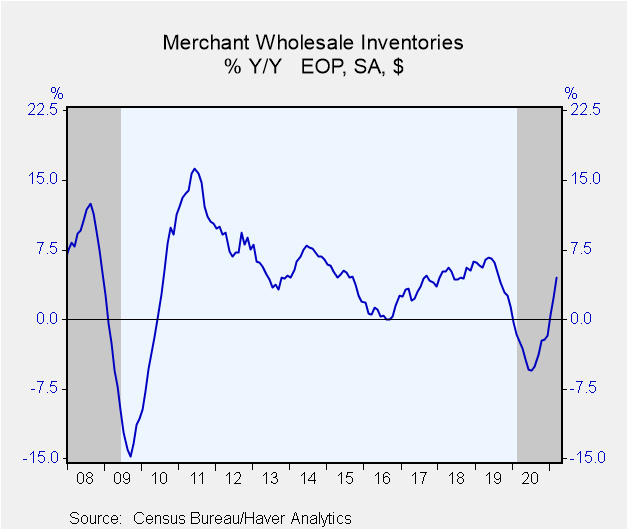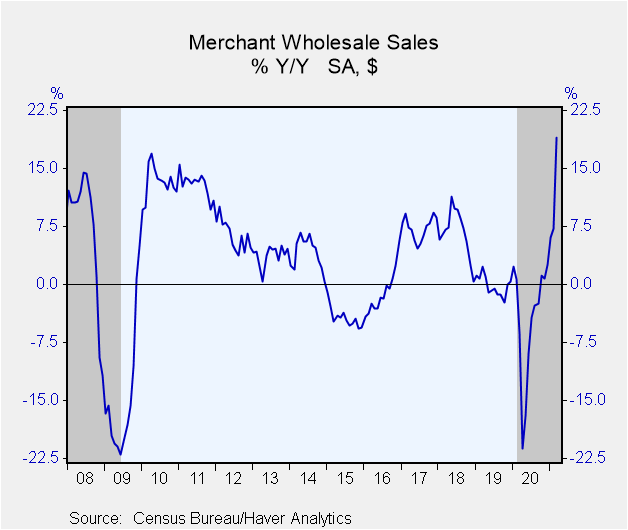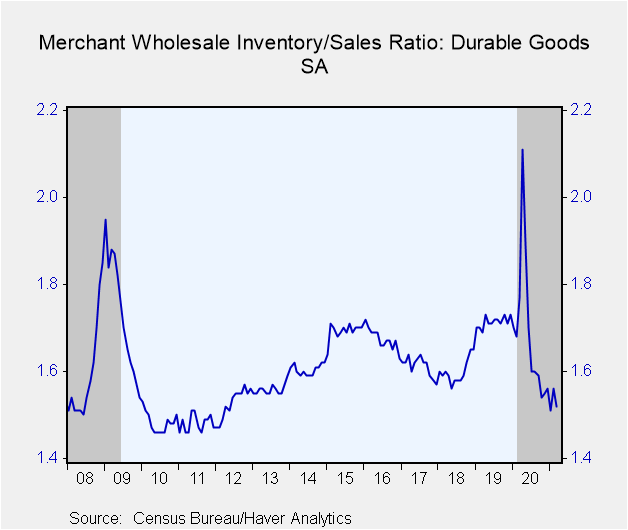 Global| May 07 2021
Global| May 07 2021Wholesale Sales and Inventories Rise Sharply in March
by:Sandy Batten
|in:Economy in Brief
Summary
• Increase in inventories widespread. • Largest monthly increase in sales since last July with upward revisions to February. • With sales outpacing inventories, I/S ratios declined. Wholesale inventories increased 1.3% m/m (4.5% y/y) [...]
• Increase in inventories widespread.
• Largest monthly increase in sales since last July with upward revisions to February.
• With sales outpacing inventories, I/S ratios declined.
Wholesale inventories increased 1.3% m/m (4.5% y/y) in March on top of an upwardly revised 1.0% monthly gain in February (initially +0.6%). A 1.4% gain had been expected in the Informa Global Markets Survey. For all or Q1, inventories were up 3.7%.
Durable goods inventories rose 1.2% m/m (0.9% y/y) in March following an upwardly revised 0.8% m/m increase in February (originally 0.3% m/m). A 3.4% m/m increase in furniture inventories led the rise though the increases were widespread. Lumber inventories gained 2.8% m/m. Computer inventories increased 2.9% m/m in March on top of a 3.4% m/m gain in February. Inventories of motor vehicles and parts increased 1.0% m/m but were down 7.2% from a year ago. Nondurables inventories rose 1.4% m/m (10.2% y/y) in March after a slightly upwardly revised 1.2% monthly gain in February (originally 1.1%). Again, gains were widespread, led by a 2.7% m/m increase in apparel and a 2.2% rise in petroleum. This was the second consecutive meaningful monthly increase in apparel inventories, which had been falling since last June.
Wholesale sales jumped up 4.6% m/m (19.0% y/y) in March after having been unchanged in February (revised up from the originally reported 0.8% m/m decline). A 2.0% monthly increase was anticipated in the Action Economics Forecast Survey. Durable goods sales increased 3.7% m/m (17.8% y/y) in March following an upwardly revised 1.9% m/m drop in February (initially -2.2% m/m). Gains were widespread, led by a 10.3% m/m jump in metals sales, an 8.6% m/m increase in lumber sales and a 5.1% gain in furniture sales. Motor vehicle sales rebounded in March, rising 4.6% m/m after a 5.9% m/m decline in February. Nondurable goods sales soared 5.5% m/m (20.0% y/y) in March following an upwardly revised 1.8% monthly gain in February (initially 0.5%). The March increase was led by a 13.8% m/m surge in apparel sales after two consecutive monthly declines, a 10.8% jump in petroleum sales (still reflecting further price increases though not nearly as large as in January and February), and a 7.0% m/m increase in chemical sales.
With the rise in sales outpacing the increase in inventories, inventory-to-sales ratios declined. The aggregate I/S ratio declined to 1.22 in March, its lowest since September 2014 and well below the record of 1.66 set in April 2020. The durable goods I/S ratio declined to 1.52 in March from 1.56 in February while the nondurable goods I/S ratio fell to 0.95 in March, its lowest since December 2014, from 0.99 in February.
The wholesale trade figures are available in Haver's USECON database. The expectations figure for inventories is contained in the MMSAMER database. Expectations for sales are in the AS1REPNA database.
| Wholesale Sector - NAICS Classification (%) | Mar | Feb | Jan | Mar Y/Y | 2020 | 2019 | 2018 |
|---|---|---|---|---|---|---|---|
| Inventories | 1.3 | 1.0 | 1.4 | 4.5 | -1.7 | 1.4 | 6.2 |
| Sales | 4.6 | 0.0 | 4.4 | 19.0 | -4.6 | -0.2 | 6.7 |
| I/S Ratio | 1.22 | 1.26 | 1.25 | 1.39 (Mar'20) | 1.38 | 1.35 | 1.28 |
Sandy Batten
AuthorMore in Author Profile »Sandy Batten has more than 30 years of experience analyzing industrial economies and financial markets and a wide range of experience across the financial services sector, government, and academia. Before joining Haver Analytics, Sandy was a Vice President and Senior Economist at Citibank; Senior Credit Market Analyst at CDC Investment Management, Managing Director at Bear Stearns, and Executive Director at JPMorgan. In 2008, Sandy was named the most accurate US forecaster by the National Association for Business Economics. He is a member of the New York Forecasters Club, NABE, and the American Economic Association. Prior to his time in the financial services sector, Sandy was a Research Officer at the Federal Reserve Bank of St. Louis, Senior Staff Economist on the President’s Council of Economic Advisors, Deputy Assistant Secretary for Economic Policy at the US Treasury, and Economist at the International Monetary Fund. Sandy has taught economics at St. Louis University, Denison University, and Muskingun College. He has published numerous peer-reviewed articles in a wide range of academic publications. He has a B.A. in economics from the University of Richmond and a M.A. and Ph.D. in economics from The Ohio State University.










